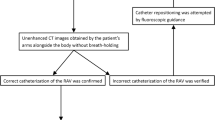Abstract
Purpose
To evaluate the usefulness of enhanced thin-slice computed tomography (TSCT) for delineating the right adrenal vein (RAV) anatomy before adrenal vein sampling (AVS).
Materials and methods
A total of 151 consecutive AVSs with CT during angiography (interventional CT) were included. Of them, TSCT was performed before AVS for 72 patients. Successful RAV cannulation was confirmed using cortisol measurement. The RAV on TSCT was classified as certain, probable, or unidentified, and cases with certain or probable RAV identification were classified as useful. In the cases where AVS was successful, the anatomical features of the presumed RAV from the useful TSCT, including the position along the inferior vena cava, vertebral level, and distance from the upper pole of the right kidney, were compared with the RAV features identified on interventional CT. Estimated successful cannulation rates before interventional CT were compared between patients with and without useful TSCT.
Results
In total, 66 TSCTs were classified as useful. The anatomical features identified on TSCT were significantly correlated with those on interventional CT. The estimated successful cannulation rates for cases with and without useful TSCT were 92.4 and 82.4 %, respectively.
Conclusions
TSCT clearly shows the anatomical features of the RAV, facilitating accurate sampling and increasing the success rate.





Similar content being viewed by others
References
Rossi GP, Bernini G, Caliumi C, Desideri G, Fabris B, Ferri C, et al. A prospective study of the prevalence of primary aldosteronism in 1,125 hypertensive patients. J Am Coll Cardiol. 2006;48:2293–300.
Douma S, Petidis K, Doumas M, Papaefthimiou P, Triantafyllou A, Kartali N, et al. Prevalence of primary hyperaldosteronism in resistant hypertension: a retrospective observational study. Lancet. 2008;371:1921–6.
Viera AJ, Neutze DM. Diagnosis of secondary hypertension: an age-based approach. Am Fam Physician. 2010;82:1471–8.
Sigurjonsdottir HA, Gronowitz M, Andersson O, Eggertsen R, Herlitz H, Sakinis A, et al. Unilateral adrenal hyperplasia is a usual cause of primary hyperaldosteronism. Results from a Swedish screening study. BMC Endocr Disord. 2012;12:17.
Melby JC, Spark RF, Dale SL, Egdahl RH, Kahn PC. Diagnosis and localization of aldosterone-producing adenomas by adrenal-vein catheterization. N Engl J Med. 1967;277:1050–6.
Auchus RJ, Michaelis C, Wians FH Jr, Dolmatch BL, Josephs SC, Trimmer CK, et al. Rapid cortisol assays improve the success rate of adrenal vein sampling for primary aldosteronism. Ann Surg. 2009;249:318–21.
Young WF Jr, Klee GG. Primary aldosteronism. Diagnostic evaluation. Endocrinol Metab Clin N Am. 1988;17:367–95.
Daunt N. Adrenal vein sampling: how to make it quick, easy, and successful. Radiographics. 2005;25(Suppl 1):S143–58.
Matsuura T, Takase K, Ota H, Yamada T, Sato A, Satoh F, et al. Radiologic anatomy of the right adrenal vein: preliminary experience with MDCT. AJR Am J Roentgenol. 2008;191:402–8.
Plank C, Wolf F, Langenberger H, Loewe C, Schoder M, Lammer J. Adrenal venous sampling using Dyna-CT—a practical guide. Eur J Radiol. 2012;81:2304–7.
Georgiades CS, Hong K, Geschwind JF, Liddell R, Syed L, Kharlip J, et al. Adjunctive use of C-arm CT may eliminate technical failure in adrenal vein sampling. J Vasc Interv Radiol. 2007;18:1102–5.
Kinnison M. Adrenal vein sampling with C-arm CT. J Vasc Interv Radiol. 2008;19:153 (author reply 153).
Onozawa S, Murata S, Tajima H, Yamaguchi H, Mine T, Ishizaki A, et al. Evaluation of right adrenal vein cannulation by computed tomography angiography in 140 consecutive patients undergoing adrenal venous sampling. Eur J Endocrinol. 2014;170:601–8.
Nishikawa T, Omura M, Satoh F, Shibata H, Takahashi K, Tamura N, et al. Task Force Committee on Primary Aldosteronism, The Japan Endocrine Society. Guidelines for the diagnosis and treatment of primary aldosteronism–the Japan Endocrine Society 2009. Endocr J. 2011;58:711–21.
Rossi GP, Auchus RJ, Brown M, Lenders JW, Naruse M, Plouin PF, et al. An expert consensus statement on use of adrenal vein sampling for the subtyping of primary aldosteronism. Hypertension. 2014;63:151–60.
Acknowledgments
We wish to thank all of the technicians at the Department of Radiology at our institute who performed the TSCT, angiography, and angio-CT scans. This work was supported by JSPS KAKENHI Grant No. 25861130. The guarantor of this study was Satoru Murata. The approval of the local ethics committee was not required because this was a retrospective study. Our previous publication [15] on angio-CT during AVS used 140 patients that overlapped with the current study.
Author information
Authors and Affiliations
Corresponding author
Ethics declarations
Conflict of interest
There was no conflict of interests in all authors.
Informed consent
Written informed consent was obtained from all patients, and the study was approved by the local ethics committee.
Electronic supplementary material
Below is the link to the electronic supplementary material.
Supplementary material 1 (MP4 7371 kb)
About this article
Cite this article
Onozawa, S., Murata, S., Yamaguchi, H. et al. Can an enhanced thin-slice computed tomography delineate the right adrenal vein and improve the success rate?. Jpn J Radiol 34, 611–619 (2016). https://doi.org/10.1007/s11604-016-0564-0
Received:
Accepted:
Published:
Issue Date:
DOI: https://doi.org/10.1007/s11604-016-0564-0




